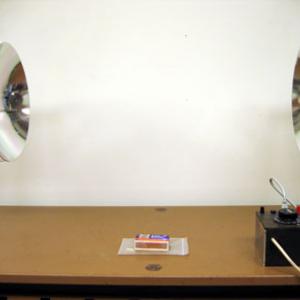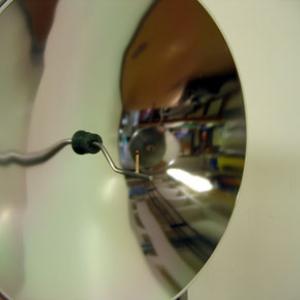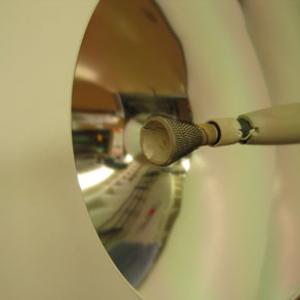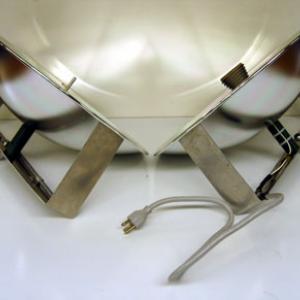College of Liberal Arts & Sciences
4B40.10 - Light the Match
Place the parabolic mirrors on rods at each end of the table. Use the rod attached to mirror with the match holder and adjust both mirrors to the same height. Make sure they are as parallel to each other as you can eyeball it, (doesn't need to be measurement accurate). Turn the Variac all the way up and wait 45 seconds. At about 30 seconds the match will start to visibly smoke and will burst into flames at about 45 seconds.
If precise alignment is necessary, you may use a radiometer as the detector to find and fine tune the focal point.
- Richard E. Berg, "Heat-Wave Focusing by Concave Reflectors", TPT, Vol. 28, # 1, Jan. 1990, p. 56.
- Thomas B. Greenslade, Jr., "19th Century Textbook Illustrations XXX - Demonstrations of Thermal Radiation", TPT, Vol. 17, # 5, May 1979, p. 320.
- James Evans and Brian Popp, "Pictet's Experiment: The Apparent Radiation and Reflection of Cold", AJP, Vol. 53, #8, Aug. 1985, p. 737.
- Julien Clinton Sprott, Physics Demonstrations, "2.14", p. 101, ISBN 0-299-21580-6.
- J. Klinger Scientific Apparatus, "Infrared Radiation", Experiments in Optics, Part 1, #14.
- W. Bolton, "The Efficiency of Reflectors on Electric Fires", Book 2 - Waves and Particles, Physics Experiments and Projects, 1968, p. 86.
- Joseph Frick, "# 372 & 373 - For Remaining Experiments in Radiant Heat", Physical Technics: Or Practical Instructions for Making Experiments in Physics and the Construction of Physical Apparatus with the Most Limmited Means, p. 447.
- "Reflectors, etc., For Radiation of Heat", Pike's Illustrated Catalogue of Scientific & Medical Instruments, Pike's Illustrated Descriptive Catalogue of Optical, Mathematical, and Philosophical Instruments, 1984, p. 98.
- The Queen Catalogues Vol. II, Catalogue of Physical Instruments, No. 4931, p. 60.
Disclaimer: These demonstrations are provided only for illustrative use by persons affiliated with The University of Iowa and only under the direction of a trained instructor or physicist. The University of Iowa is not responsible for demonstrations performed by those using their own equipment or who choose to use this reference material for their own purpose. The demonstrations included here are within the public domain and can be found in materials contained in libraries, bookstores, and through electronic sources. Performing all or any portion of any of these demonstrations, with or without revisions not depicted here entails inherent risks. These risks include, without limitation, bodily injury (and possibly death), including risks to health that may be temporary or permanent and that may exacerbate a pre-existing medical condition; and property loss or damage. Anyone performing any part of these demonstrations, even with revisions, knowingly and voluntarily assumes all risks associated with them.



